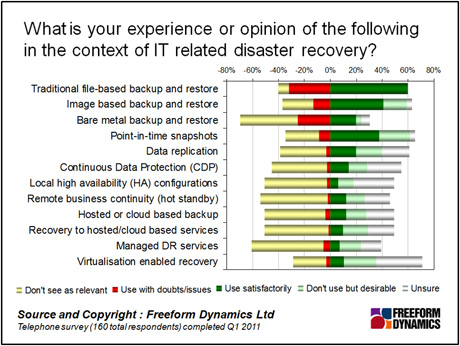It is recognised across almost all companies that disasters or major events can interrupt business processes and that it is important to be prepared to resume operations in a timely way should the worst happen. While this awareness is widespread, the results of one of our recent surveys highlighted that the majority of SMBs recognise that their ability to recover from disaster is nowhere near as comprehensive as it should be.
Although only around a quarter of SMBs participating in the research have formal ‘disaster recovery’ (DR) plans, most have less formal measures in place to get a recovery underway after a major incident. Indeed, countering the myth of widespread ignorance and apathy, only around one in six organisations surveyed say they don’t spend a lot of time thinking about risk management in this area.
However, the lack of specific focus results in many SMBs managing disaster recovery as quite a diffuse part of a broader set of IT operations. Juggling competing priorities means that investment is not readily available to dedicate to addressing existing weaknesses in resilience.
The result is that from a channel opportunity perspective, stand-alone DR initiatives will be quite rare. One possible way to drive more sales activity will be to work with prospective customers to crystallise their business need in order to get funding committed for DR projects. This is possible to do, but can be a difficult and lengthy sales cycle to bring to fruition, because you first need to convince the customer to create an over-arching DR initiative.
Another approach is to look at expanding the remit of other projects, through up-selling and cross-selling, to include DR related elements. This approach is often going to be an easier sell due to the budgets already committed and an incremental approach, but it does require being able to identify which initiatives are most likely to receive investment.
There are many potential areas that you could focus on when it comes to cross-selling DR, but a common problem is that that they are often not seen as all that relevant by default, or else tend to have perceived implementation issues.

Figure 1
An obvious question looking at the last item on this chart is how to tap into the virtualisation activity that is already happening or is under consideration.
Exploring this further, despite all the hype that’s surrounded virtualisation for the last half-decade, when it comes to the SMB market virtualisation is more the exception than the rule. Less than one in 5 respondents reported that they had virtualised more than half of their x86 server infrastructure, while more than half said there was little to no virtualisation at all.

Figure 2
At first glance, this may seem like trying to sell virtualisation enabled DR is a lost cause due to a lack of interest. Virtualisation in the SMB market, though, is set to see a marked increase over the coming few years.
This is important, because prospective customers are already ‘warmed up’ to the idea of deploying virtualisation. An additional benefit is that projects will be starting almost afresh in many cases, allowing more freedom to shape the proposed solution or use-case rather than trying to retrofit a solution once in place and with established operations depending on them.
When it comes to just where virtualisation can help enable DR, there are a number of areas that SMBs view it as helpful. The principle benefit that most latch onto is having a much more flexible approach to restoring services by being able to recover to alternative hardware. This can be further exploited by allowing recovery “in the Cloud” by restoring to stand-by machines hosted in an external facility. Other benefits that virtualisation is seen to bring to DR is the simplification and speeding up of the recovery process.
To take advantage of DR and virtualisation being a good fit, skills and experience that span both are necessary. However, they are limited in the SMB space, which means that skills in Microsoft in particular, but also VMware and Citrix will be important to enabling successful implementations.
The bottom line is that many SMBs have little awareness of the solutions that are available to them to improve both their ability to deal with IT DR scenarios as well as better protect data in daily IT operations. By building a DR practice and associated propositions on top of virtualisation you can take advantage of the coming wave of adoption.
CLICK HERE TO VIEW ORIGINAL PUBLISHED ON

Registration Required